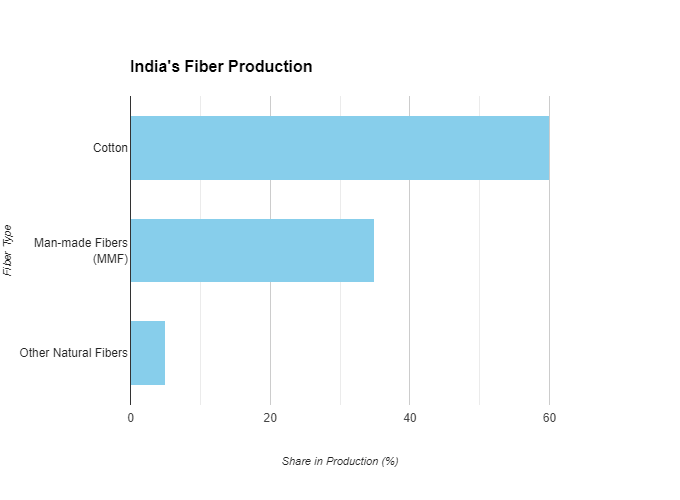India's fibre production remains strong with rising domestic demand and government initiatives.
Global fiber production reached a record-breaking 124 million tonnes in 2023, a robust recovery in the textile industry after the disruptions caused by the pandemic. As per Textile Exchange's ‘Materials Market Report’, this indicates a growing demand for textiles worldwide.
China, India lead global production
The report highlights the dominant role of Asia in global fiber production, with China and India leading the pack. China lead the pack with 52 per cent share and India follows at 18.3 per cent. The US, Pakistan and Brazil are the other top fiber producers.
Table: Top five fiber producers in 2023
|
Country |
Share (%) |
Production (mn tons) |
|
China |
52.4 |
65 |
|
India |
18.3 |
22.7 |
|
US |
5.6 |
7 |
|
Pakistan |
3.2 |
4 |
|
Brazil |
2.4 |
3 |
India's growth curve
India has a mix of natural and synthetic fibers. As per the Ministry of Textiles, major fibers produced in India are:
Cotton: Remains the dominant fiber, accounting for approximately 55 per cent of total production. Cotton is expected to witness steady growth, driven by increasing domestic demand and export opportunities. The Confederation of Indian Textile Industry (CITI) projects an annual growth rate of 3-4 per cent in cotton production over the next five years.
Jute: A significant contributor, particularly in the eastern region, with a share of around 15 per cent. Jute production is projected to grow at a moderate pace, with increasing focus on diversification of jute products and government support for the industry. The National Jute Board estimates a growth rate of 2-3 per cent per annum.
Man-made fibers (MMF): Polyester, viscose, and acrylic are the leading MMFs, collectively accounting for about 30 per cent of production. MMF is anticipated to witness the fastest growth, due to rising demand for synthetic textiles and increasing investments in MMF production capacity. The Fiber Year Consulting projects an annual growth rate of 5-6 per cent for MMF in India.
Table: India's fiber production
|
Fiber Type |
Share in India's production |
Growth projection (2023-2028) |
|
Cotton |
60% |
4-5% |
|
Man-made Fibers (MMF) |
35% |
8-10% |
|
Other Natural Fibers (Jute, Silk, Wool) |
5% |
3-4% |
Overall growth in fiber production in the country is due to several factors. One major reason is strong domestic demand. India's burgeoning population and rising disposable incomes have pushed up in demand for textiles, driving fiber production. The government's focus on promoting the textile industry through initiatives like the Production Linked Incentive (PLI) scheme has incentivized investments in fiber production. And a growing awareness of sustainability has led to increased demand for eco-friendly fibers, and India is well-positioned to capitalize on this trend with its rich tradition of cotton cultivation and natural fiber production.
Even though fiber production remains in the positive domain the sector does face its own set of challenges. The industry needs to address issues such as water scarcity, pollution, and labor rights to ensure sustainable growth. Additionally, India needs to invest in technology and innovation to compete with other global players.
However, the opportunities are immense. India's vast domestic market, coupled with its potential to become a global hub for sustainable textile production, presents a bright future for the industry. The growth in fiber production is a testament to India's resilience and its ability to adapt to changing global trends.

